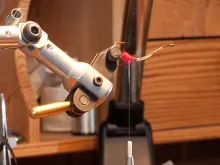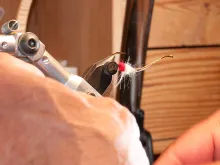A realistic, perfect swimming shrimp imitation for both hot and cold water and a big variety of species. The fly has many neat details and is a great upgrade from those quickly tied flies. It makes your fly box look great and keeps you away from the TV.
Facebook & Fly Swap!
I don't use Facebook that much, actually only when someone writes me. Why? Well, I just haven't really been diving into it. One day a guy byt the name of Kern Leo Lund from Denmark sent me a message asking if I was the Kasper Mühlbach--the guy with a few articles under his belt who was a part of the Global FlyFisher team. No matter how much I played modest, I couldn't find a way not to reply positively to this question, and the result was that he sent me a box of flies. It only took 11 days from Denmark to South Sweden - but I got them. In the box were two nice shrimps with clear legs ready to jump out at me or at least crawl out over the door step and into the nearby water at first chance.
They looked great and I took a couple of photos. We kept writing back and forth on Facebook and decided to make a small article about how to tie this fly--exclusively for GFF!
I asked a little about the tying technique and if the tail made the shrimp spin and thereby the leader curl. Kern said that it swam perfectly in the water, but my skepticism made me dress in waders and go for an hour in the evening, since there was no need to publish a fly that would cause more frustrations than joy.
Test fishing
It is hot. Not too much, actually just nice. The moon is showing half of its face - golden pale. The ducks and herons are making their weird songs and small ducklings are racing on the surface snapping midges. They must spend more energy catching them than they gain from eating them. But they seem to have fun.
I tie on the fly and make my way through the forest to the shore. The flowers and grass is knee high at least. It smells fresh, dry and natural. It is finally summer.
I step into the water and walk slowly to the reef. The sea is like a mirror. The line comes off the reel. Nice sound. It almost sounds like a fish making short, wild runs. I cast 5 meters and drag the rod, so the fly passes me close by. Kern was right. It looks great and it does not spin. More line is pulled of the reel and the fly penetrates the surface a few moments later with a silent little "plop".
One pull and I feel a fish. It hooks itself. I am surprised. So is the fish. At first it just follows the line and comes towards me. Not a big one, I guess, but a fish is a fish and this one came out of the blue. It turns when it sees me. The tail is bigger than I thought. What a coincidence. Normally I hate these stories beginning with:
"Yesterday I tied this fly bla bla bla... and today it proved it's value. I caught 7 nice fish and named the fly 7killsfly..."
And here I am. The fact is that I have received a fly, tied it on and in first cast it's taken by a three kilo sea trout. Is it the fly or is it the angler...?
I admire the fish. It is heavy, well-proportioned and and absolutely perfect. I'd better call my friend
Anders just to check if his on his way with the camera.
He is.
We fish for a few more hours and have a few contacts and release two fish. It is dark when we decide to call it a night. The moon has disappeared behind the trees when we try to find a path through the wilderness. What a nice test fishing!
The meeting
The day for taking photos for the step-by-step instruction was closing in. Who was this guy? Kern? Strange name, even by Danish standards, by the way. Well, at least as strange as Mühlbach. I had seen his flies on a few Danish sites. What characterized them was a sense of detail and perfect tying.
The road ended blindly. 3 houses without numbers. I parked my car. Checked the mailbox. A door opened. "Yeah - you are right. It is here!".
Kern - not the smallest man on earth.
Kind of a body builder type.
And that's exactly what he is. Body builder, The oldest pro in Denmark at the moment. Dedicated to his training and competing in the league for more than twenty years. He is a serious competitor. Maybe competing with himself, mostly. He wants it to be OK. The house, furniture and surroundings is the same. Just OK! No doubt he is a sensing person--a perfectionist.
A medal hangs above his fly tying desk from Mustad Open 2002. A second place. The second second place, actually. He laughed. He had got an reply from the committee explaining the reason. He couldn't see it.
He shows me some of the flies used for tuna, trevally and sea trout. Of course they are different, but they are all tied to perfection - to a very high standard. That is another thing what drives him. Tying high standard flies for fishing, with neat details that just add this little extra realistic look. The look as we as humans believe in (the sea trout probably do not care that much). He has been working on this shrimp for some time now, and it is finished. Time for a public release.
|
|
|
|
|
|
|
|
|
|
|
|
|
|
|
|
|
|
|
|
|
|
|
|
|
|
|
|
|
|
|
|
|
|
|
|
- Log in to post comments












































Dear Kern, pleased t
Dear Kern, pleased to meet you. Writing from Italy. About Kern's Perfect Leo Shrimp...... simply perfect. Do you sell some of these creatures?
Best Regards
Hello to all of you
Hello to all of you fanatics..isn't it novel to what extremes a flyfisherman/tyer will export his energies to the developement a single pattern,such as this inovative shrimp by Kern Leo Lund. Hands down,a winner! The photowork is definitely satisfiying. Thanks tons for this technique. Tom Gibbons
Jakob,
I might ad
Jakob,
I might add a few more photos, but I need to know exactly what you are missing. What details do you want to have illustrated better?
Kasper
Hey Martin
I know
Hey Martin
I know I know you have a lot all ready :0). I acknowledge the great work you do off course. The only thing i was aiming at was more pictures of the final fly, but I will have to settle with 40 it seems ;0).
Best wishes
Jakob
Jakob,
More pictu
Jakob,
More pictures...?! This article has almost 40 pictures already! We can hardly squeeze more in... The number of images found on any of our patterns surpasses what you find on most pattern articles on the web by an order of magnitude (well, almost...).
These images were all shot during a "live" tying of the fly, as is most of our step-by-step photos, and it can sometimes be difficult to control the background. But if you click on the images to see the larger versions you will see lots of details.
Doing an article such as this one is more than enough work as it is, and supplying shots on different backgrounds is unfortunately beyond our resources. We are after all doing this for fun and for free.
Martin
Hey
What about mo
Hey
What about more pictures. The ones you have posted are great but it would great with more details. It would be great to see it on a lighter background also.
But great article and great great fly.
Best wishes
Jakob
Dabe,
you are rig
Dabe,
you are right. The fly tied min the step-by-step sequence does not include EP fibres. The version tied upside down does, though.
You can use either material, but the fly gets a more transparent look using the rubber bands.
Kasper
This is not just
This is not just a great looking fly, i's also a great fish catcher. For the last couple of years I have almost exclusively fished with Kern's Leo Shrimp and Agerskovs Honey Shrimp, when chasing seatrout of the Danish coast.
I just have one question for tying this great looking modified version. On the material list it says there is a back/carapace made from EP fibres, but in the step-by-step this is left out. Should the rubber legs be positioned under or over the EP fibres.
Folks, Here's an other
Folks,
Here's an other likely source for elastic leg material. Moderate size spools, good prices and both clear and in many colors.
Martin
this is a terriffic
this is a terriffic searching pattern with applacations on many species of fish ,,, the rubber legs you metion,, any help on locating the material would be appreciated,,,thank you for shareing this this little wonder,,
Guys, Kern spent
Guys,
Kern spent some hours on the net and found out what he had on his fly tying desk. It is a rubber band used for making trinkets.
It is called Crystal tec and can be bought in kilometers here (or just 100 meters!) (the site is in Danish!).
The one used on Kern's Perfect Leo Shrimp is 0.5 mm.
Kasper Mühlbach
Hi, today I bought P
Hi, today I bought Pearl barred Sili Legs distributed by Veniard. It looks very interesting and do the job well.
Oh Leo, that is the
Oh Leo, that is the best looking shrimpfly you have ever created. looking forward to see you catch many big seatrout this fall, when we go fishing together. Maby someday, i will come by your house, and get some off your rubber legs.
See you, my friend.
Hi,
a few years ago
Hi,
a few years ago i found in a Hobby Shop in Berlin that material called (of course in german (or denglish :^))) "Stretchgummi" and sold in different thicknesses.
I guess it is used for small chains and can pulled over the wrist, because it is flexible.
...
There is also a nice article on this website from Steve Schweitzer .. he used as ribbung a material called: "Stretch Magic" ... i guess that is the same stuff like Stretchgummi.
Best regards from Berlin - Thomas
PS: It seems that Kern's Shrimp not only catch fish ... also the fisherman too :^)
Erik and Tob,
The
Erik and Tob,
The rubber that Kern is using was found at his workplace on the spool. No one know what it is and where it came from. Kern is now trying to find out even though he has several kilometers.
Clear flexi legs might be available at Go-Fishing.
Kasper
Great fly. Where did
Great fly. Where did you got that rubber legs from? I was looking for them on the internet, but found nothing so far.
Great looking shrimp
Great looking shrimp! But where can I find the needed materials? I searched the web but came up empty handed... Thanx!
Erik
What a great looking
What a great looking shrimp! But.. I've been searching the web for the clear flexi legs but I can't seem to find them. Anyone know where to get them? Thanx!
Kasper, Kern,
ver
Kasper, Kern,
very interesting pattern, nice pictures, and "something to do" until September. And the way to the perfect shrimp has one more chapter. Thanks for sharing.
Rgds,
Ole
i am sure peacock ba
i am sure peacock bass takes this too!
That is a great patt
That is a great pattern!